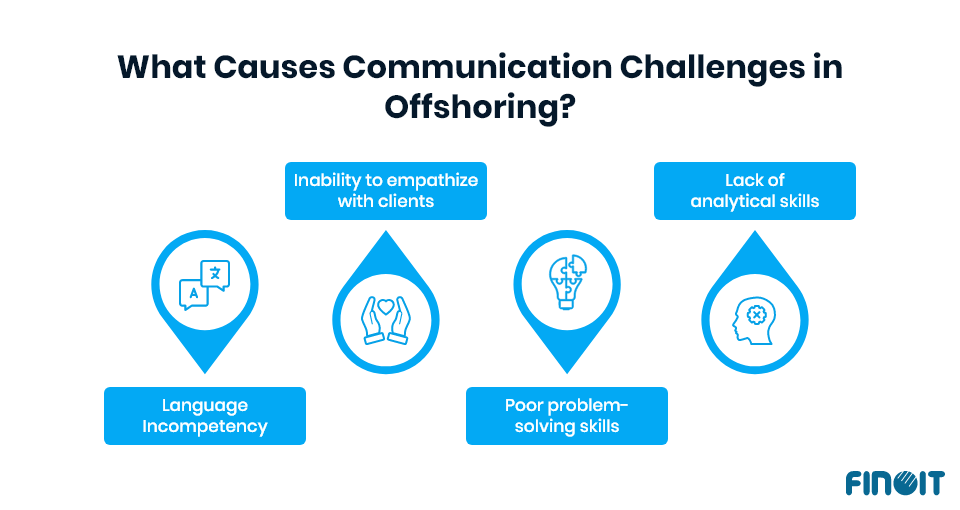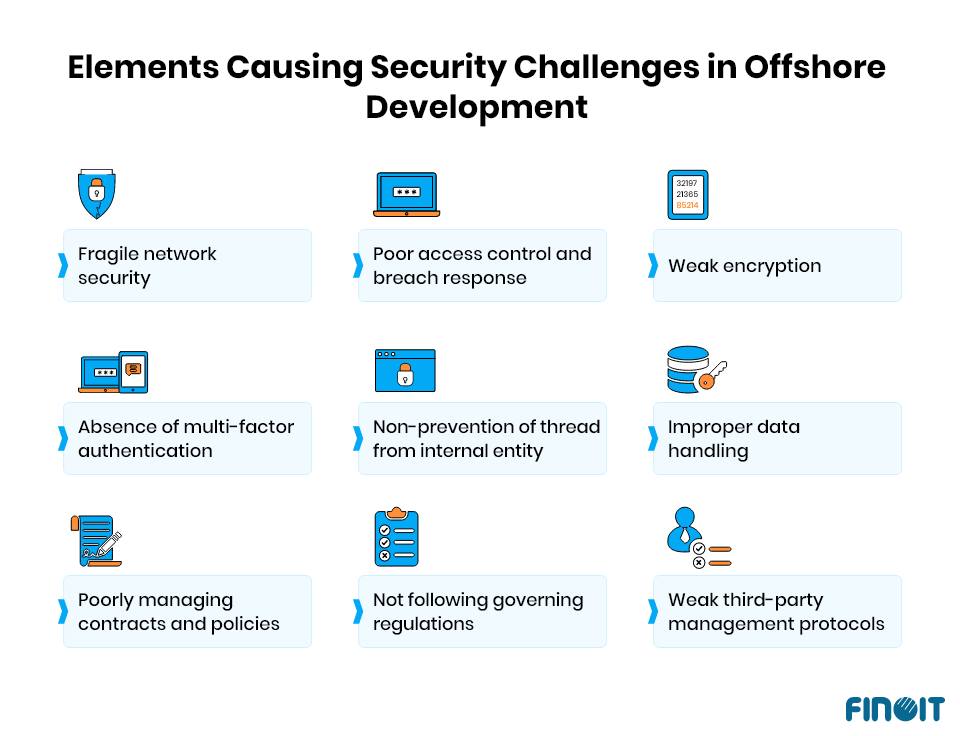Uncovering Key Challenges in Offshore Software Development

Poor coding capabilities, fragile quality framework, lack of business understanding, communication gap, and improper project management can all take a heavy toll on software development. Explore how inefficiencies brought by these elements make offshore development challenging.
Ginni Rometty, an influencer and former CEO of IBM, once noted that “the benefits of offshoring are clear: access to lower-cost labor, increased efficiency, and the ability to tap into new markets.” But her next words reflect caution for those choosing offshoring, as she adds “but it’s important to approach offshoring strategically and with a long-term perspective.” Hidden in the veteran IT leader’s words is a message that offshoring may be an exciting prospect, but your approach must also consider its all dimensions.
Undeniably, offshoring has always been a tempting choice for companies from the US, Europe, and Australia. For more than two decades, businesses from these geographies have been outsourcing their software development projects to offshore destinations like Asia and Eastern Europe.
And why not? Finally, offshore software development services offer a promise of saving almost 80% cost, when compared with hiring local talent, and who wouldn’t want to secure this massive cost advantage?
However, is securing advantage with offshoring that easy? Indeed, not. While the offshore model is something that a business would like to avail itself of, it poses several challenges to its adopters. When going unmanaged, these challenges turn into potential roadblocks, raise costs, and affect the bottom line.
When you are familiar with challenges, it helps you in equipping yourself with the right ways to deal with them tactically. As a result, here we discuss some of the most common challenges that hamper the application development process when going with the offshore model.
Major challenges that disrupt software development when working with an offshore partner
Offshore development comes with its own set of challenges, which must be addressed to reduce their impact on the SDLC and ultimately on your end product. So, let’s take a closer look at some of the most prevalent offshore software development challenges.
Ensuring perfection
Different countries that host offshore development centers have high turnover rates. With these high rates, there is always a chance of losing project knowledge and expertise. This can affect project efficiency, speed, and quality.
It is simple to maintain track of each team member, their tasks, and approaching deadlines while working with an in-house team. This is obviously more difficult with a team thousands miles away, operating in a different time zone.
That is why establishing project management tracking systems is vital to overcome the offshore development challenges. The ideal method to accomplish this is to create a productivity tracker in which each team member records their tasks, progress, and delays. These tools and processes can provide transparency and visibility into the progress of the project, allowing for early identification and resolution of potential issues.
Synchronization
As we all know, an offshore location is a long distance away, and businesses cannot afford to travel so much. As a result, the only expectation from the software developer is to be upfront and communicative. Ensuring that all stakeholders are on the same page and building trust is always thus an issue in offshore development.
It is critical to use communicative apps that are transparent and effective in order to restore trust between the two firms. Technology has advanced to the point where you can easily keep an eye on what the firm is doing and how your project is progressing. Several apps such as Skype, Slack, Jira, Silo and other project management tools that help simplify your vision and keep you up to date on what your organization is capable of providing.

Making accurate estimates
Project estimates and timely releases is one of the major offshore development challenges. For example, in 2006, IBM received a $863 million contract from the State of Texas, under which IBM was responsible for unifying the state government’s data center operations and providing other particular services.
The state expected to save hundreds of thousands of dollars over the IT system, but the project quickly became stalled due to the higher prices, with no one understanding who was to blame. Four years later, in 2010, the number of completed projects was only 12%.
The ideal way to handle this software development challenge is to use scrum, a popular agile approach that allows us to divide the entire project development path into smaller sprints with fixed deadlines. The team members have direct access to the ongoing development work and are involved in the estimating and planning processes, which reduces the chances of them going off track.
Guarding against threats
Tons of code, data, information, and documentation flows during the entire development process. Weak security protocols act as an Achilles’ heel which can bring down the entire project at any moment, if these sensitive elements land in the wrong hands.
The technicalities of security, such as encryption, access control, and data backup, are at stake when the security framework of an offshore vendor is fragile. It can jeopardize your project.
One example is the 2017 Equifax data breach. Equifax, one of the largest credit reporting agencies in the United States, had outsourced some of its IT operations to an offshore vendor based in Argentina. Hackers were able to exploit a vulnerability in the offshore vendor’s software, which gave them access to Equifax’s systems and allowed them to steal sensitive information from millions of customers, including names, social security numbers, birth dates, and other personal information.
This incident demonstrates the importance of ensuring that offshore partners follow required norms in data, code, and information security. Failure to do so can result in serious consequences for the business, including reputational damage, financial losses, and legal liability.

Ascertaining Standard
According to a Harvard Business Review, organizations that define metrics informally frequently end up with costly errors and lengthy gestation periods. Only companies that set error tolerance limits, establish completion times and productivity norms, and regularly assess staff performance are capable of providing quality offshore solutions.
When companies offshore, they have no way to determine whether the providers executed those operations better or worse than their personnel. The reason is they have not ascertained if the partner has any mechanism to track and monitor quality KPIs.
As a client it is always a tough job to ensure that all quality metrics are at par with what the accepted standards require. The chances of quality getting sacrificed by your offshore vendor are always high, if it fails to monitor key metrics, which include:
- Code Quality: Readability and Clarity
- Reliability: Mean-Time-To-Repair (MTTR) and Mean-Time-Between-Failure(MTBF)
- Maintainability: Mean-Time-To-Change (MTTC)
- Integrity: Integrity flexibility and Control on integration
- Performance: Degree to which requirements are being met
Issues in quality occur due to failure to monitor these KPIs. Since, each process comes with its own set of KPIs monitoring each of them and ensuring the efficiency of the development process is a cumbersome process.
Regulating Control
A dispute of authority is one of the major challenges of offshore software development that companies face. When a business outsources its project to an offshore vendor, the latter takes ownership of all decisions about source codes, intellectual property rights, and any other form of advancement.
Like Hertz hired a known software development giant in 2017 to design a technology platform for which it spent months planning, setting goals, strategies, business planning, and developing roadmaps. The partner, on the other hand, deliberately ignored some of the platform’s scalability requirements in the beginning and only permitted it to be applicable to the region. This made it impossible for the corporation to use it outside of North America, where it was used by several companies.
So, clarity on project ownership is an important consideration in offshore development, as it can be tough for businesses to approve since they need to become acquainted with the vendor to whom they are offshoring. As a result, decision-making authority becomes a worry for both parties, which can lead to coordination and management issues.
Scaling by defying distance
Cultural differences can be a one of the potential offshore development challenges barrier in offshore outsourcing. When working with a team located in a different country, businesses may encounter differences in communication styles, work ethics, time zones, holidays, and business practices.
However, many offshore outsourcing companies recognize the importance of cultural alignment and invest in training and resources to bridge the cultural gap. This can include language training, and communication protocols tailored to the specific needs of the client’s business.
Ultimately, while cultural differences can present challenges in offshore outsourcing, they can also offer opportunities for learning and growth. By embracing cultural diversity and investing in resources to promote cross-cultural understanding, businesses can foster a collaborative and productive relationship with their offshore team.
Skill and Talent Validation
Most common challenges in offshore development is IT companies highlight what they can give their clientele. Nonetheless, there have been cases where businesses demonstrate something but know very little about implementation. They are ineffective in any development technology framework and architecture since they lack understanding and technical expertise.
For example, All Virgin Airlines airport operations were unexpectedly terminated in 2010. More than 50,000 travelers were stranded and their flights were canceled for 24 hours. The problem was caused by Navitaire’s Internet booking, reservation, check-in, and boarding system errors. But, when this occurred, their offshore partner was unable to fix it as required by the contract, and they also opted not to move to backup hardware, leaving Virgin Airlines with a significant financial, loyal customer, and reputational loss.
Hence, before deciding to offshore, businesses must determine what the firm is capable of giving, as well as what best practices they follow and offer. Because of a lack of knowledge and competence, firms may be unable to deliver what their customers seek.
Overcome these pain points with ease
Indeed, nothing in our life is flawless, and offshoring is not a perfect collaboration model either. There are numerous problems that both clients and vendors must face in order to produce a perfect software solution. Even when working with the best vendors, mistakes are conceivable, and you should keep this in mind, especially given the complexities of interacting with people on the other side of the globe.
There are certain challenges on the client’s side as well, which you should try to resolve in order to maintain smooth communication. Strive to build a solid and trusting relationship with your customer, avoid isolating your team from the offshore team, and ensure that all of your team members function as a single entity rather than distinct units.
Choosing a good custom software development agency, establishing honest and regular communication, and being realistic about your goals are the essential components that will assist you in overcoming these potential challenges.

